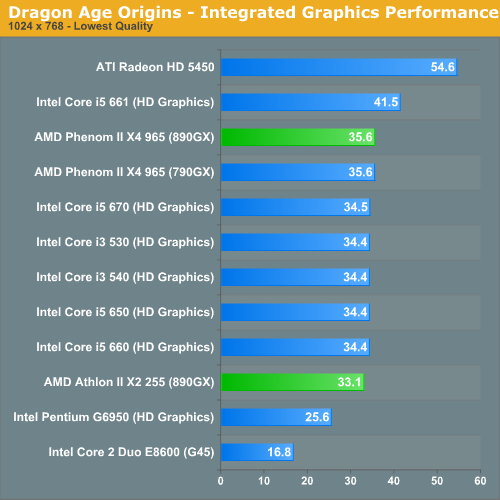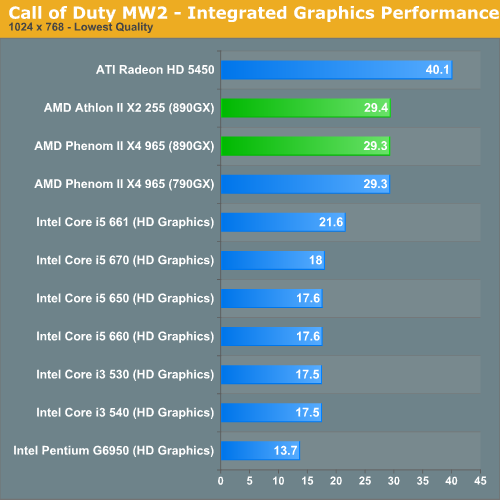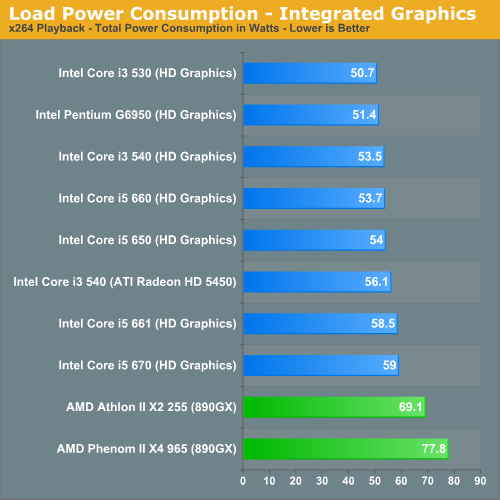The Rest of Clarkdale: Intel's Pentium G6950 & Core i5 650/660/670 Reviewed
by Anand Lal Shimpi on March 24, 2010 4:00 PM EST- Posted in
- CPUs
Integrated Graphics Performance
In our 890GX review I looked into integrated graphics performance of the entire Clarkdale lineup vs. AMD's chipset offerings. You can get a look at the full set of data here, but I'll also provide a quick summary here.
Intel's best case performance happens in our Dragon Age Origins benchmark:

Thanks to its 900MHz GPU clock the Core i5 661 does much better than AMD's integrated graphics. The rest of the Clarkdale lineup is basically on par, and the Pentium G6950 is a bit slower. Note that the G6950 is still over 50% faster than G45. That was just a terrible graphics core.
The worst case scenario for Intel's integrated graphics comes up in Call of Duty Modern Warfare 2:

Here even the Core i5 661 can't best AMD's 890GX. Intel's integrated graphics performance can range from much slower to competitive if not faster than AMD's depending on the game. Unfortunately in a couple of key titles Intel is much slower. Using GPU clock speed as a means to differentiate CPUs isn't a wise move if you're trying to build up your reputation for not having terrible graphics.
If you're not going to do any gaming and you're using the integrated graphics for Blu-ray playback, it's a much better story for Intel.

Under load the entire Clarkdale line is very conservative with power consumption.
Full Data in Bench & The Test
We're presenting an abridged set of benchmarks here in the review to avoid this turning into too much of a graph-fest. If you want to see data that you don't see here check out all of these CPUs and more than 100 others in Bench.
| Motherboard: | ASUS P7H57DV- EVO (Intel H57) Intel DX58SO (Intel X58) Intel DX48BT2 (Intel X48) Gigabyte GA-MA790FX-UD5P (AMD 790FX) |
| Chipset Drivers: | Intel 9.1.1.1015 (Intel) AMD Catalyst 8.12 |
| Hard Disk: | Intel X25-M SSD (80GB) |
| Memory: | Qimonda DDR3-1066 4 x 1GB (7-7-7-20) Corsair DDR3-1333 4 x 1GB (7-7-7-20) Patriot Viper DDR3-1333 2 x 2GB (7-7-7-20) |
| Video Card: | eVGA GeForce GTX 280 |
| Video Drivers: | NVIDIA ForceWare 180.43 (Vista64) NVIDIA ForceWare 178.24 (Vista32) |
| Desktop Resolution: | 1920 x 1200 |
| OS: | Windows Vista Ultimate 32-bit (for SYSMark) Windows Vista Ultimate 64-bit |










70 Comments
View All Comments
know of fence - Friday, April 9, 2010 - link
Unlike to the apologists above, it should be obvious to most readers that testing power consumption with discrete graphics further dilutes results, especially regarding power savings.Even if Anandtech absolutely cannot do those tests (because of bench), at least a mention of the EVGA Graphics card's idle power consumption (~ 25W ?) in the description would be really helpful. So readers who care about absolute watt power could then subtract it from benched measurements, to get a meaningful power consumption estimate for a non-gaming- PC.
ReaM - Thursday, March 25, 2010 - link
Qimonda DDR3-1066 4 x 1GB (7-7-7-20)Corsair DDR3-1333 4 x 1GB (7-7-7-20)
Patriot Viper DDR3-1333 2 x 2GB (7-7-7-20)
Which one is used for O'Clocking?
I need a good OC ram! :P I dont know which company
Thank you!
Calin - Thursday, March 25, 2010 - link
Try to post in the forums, you might be luckierReaM - Thursday, March 25, 2010 - link
yeah, but these were used here in that test setupekul - Thursday, March 25, 2010 - link
I don't think anyone is going to buy this chip at their local computer shop. Even for a cheap HTPC you'd be much better off to get a full clarkdale for the hyperthreading and turbo mode.This chip was built so OEMs like Dell and HP can keep the base price of their H55-based systems low to entice buyers. It's also as much CPU as any CSR or assistant is going to need in the corporate world.
arnd - Thursday, March 25, 2010 - link
It appears that there are two more Clarkdale processors, the Celeron G1101 (with just 2 MB L3 cache) and the Xeon L3406 (with 30 W TDP but graphics disabled).xpax - Thursday, March 25, 2010 - link
Good job, Anand, as usual.I don't keep up on the hardware front as much as I used to, and having just built a new i5-750 system I was concerned for a moment as I hadn't heard about these new chips before doing my build.
After seeing the numbers though, I'm 100% sure I made the right choice.
iwodo - Wednesday, March 24, 2010 - link
I want SandyBridge, i dont know why i never liked this generation architecture. I still have the perception ( no matter how much benchmark i read ) that it simple doesn't offer any performance improvement over C2D or those previous cheap Core2 Quad.Spending $100+ ( or $200+ since you need to upgrade your MB ) simple doesn't make sense. I would rather buy a Fermi / 58xx or Sandforce Based SSD.
kaleun - Wednesday, March 24, 2010 - link
As a C2D owner I also don't see much reason to upgrade to an i3. but if I needed more performance, the i5/i7 would be worthwhile. and many people might upgrade from something older than C2D. If I started a PC from scratch, the i3 for $ 120 is really really good compared to everything else in that price range if one considers power consumption and overclocking.Obviously, someone who buys an i3/i5/i7 today won't see much reason to upgrade to Sandy Bridge either. But starting from an older platform (even C2Q), Sandy Bridge will be worthwhile. I almost think, unless you are power user, one always is best off skipping every other CPU generation.
the thing I wonder, for someone who builds a new platform today, why would anyone buy a new C2D is beyond me. My E7400 still costs $ 120 like over a year ago when I bought it. No way I'd buy that over an i3.
Calin - Thursday, March 25, 2010 - link
You could buy an C2D for common installed base (with similar mainboards as other PCs you have installed). Or you might buy one for the perfect last-generation board you buy for a new computer.There might be other reasons, but I don't have one of them right away